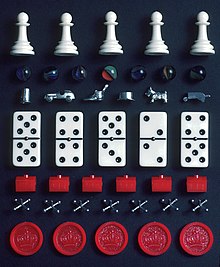Definitions

| Look up game in Wiktionary, the free dictionary. |
Ludwig Wittgenstein
Ludwig Wittgenstein was probably the first academic philosopher to address the definition of the word game. In his Philosophical Investigations, Wittgenstein argued that the elements of games, such as play, rules, and competition, all fail to adequately define what games are. From this, Wittgenstein concluded that people apply the term game to a range of disparate human activities that bear to one another only what one might call family resemblances. As the following game definitions show, this conclusion was not a final one and today many philosophers, like Thomas Hurka, think that Wittgenstein was wrong and that Bernard Suits' definition is a good answer to the problem.
Roger Caillois
French sociologist Roger Caillois, in his book Les jeux et les hommes (Games and Men), defined a game as an activity that must have the following characteristics:
- fun: the activity is chosen for its light-hearted character
- separate: it is circumscribed in time and place
- uncertain: the outcome of the activity is unforeseeable
- non-productive: participation does not accomplish anything useful
- governed by rules: the activity has rules that are different from everyday life
- fictitious: it is accompanied by the awareness of a different reality
Chris Crawford
Game designer Chris Crawford defined the term in the context of computers. using a series of dichotomies:
- Creative expression is art if made for its own beauty, and entertainment if made for money.
- A piece of entertainment is a plaything if it is interactive. Movies and books are cited as examples of non-interactive entertainment.
- If no goals are associated with a plaything, it is a toy. (Crawford notes that by his definition, (a) a toy can become a game element if the player makes up rules, and (b) The Sims and SimCity are toys, not games.) If it has goals, a plaything is a challenge.
- If a challenge has no "active agent against whom you compete", it is a puzzle; if there is one, it is a conflict. (Crawford admits that this is a subjective test. Video games with noticeably algorithmic artificial intelligence can be played as puzzles; these include the patterns used to evade ghosts in Pac-Man.)
- Finally, if the player can only outperform the opponent, but not attack them to interfere with their performance, the conflict is a competition. (Competitions include racing and figure skating.) However, if attacks are allowed, then the conflict qualifies as a game.
Crawford's definition may thus be rendered asoriginal research?: an interactive, goal-oriented activity made for money, with active agents to play against, in which players (including active agents) can interfere with each other.
Other definitions, however, as well as history, show that entertainment and games are not necessarily undertaken for monetary gain.
Other definitions
- "A game is a system in which players engage in an artificial conflict, defined by rules, that results in a quantifiable outcome." (Katie Salen and Eric Zimmerman)
- "A game is a form of art in which participants, termed players, make decisions in order to manage resources through game tokens in the pursuit of a goal." (Greg Costikyan) According to this definition, some "games" that do not involve choices, such as Chutes and Ladders, Candy Land, and War are not technically games any more than a slot machine is.
- "A game is an activity among two or more independent decision-makers seeking to achieve their objectives in some limiting context." (Clark C. Abt)
- "At its most elementary level then we can define game as an exercise of voluntary control systems in which there is an opposition between forces, confined by a procedure and rules in order to produce a disequilibrial outcome." (Elliot Avedon and Brian Sutton-Smith)
- "A game is a form of play with goals and structure." (Kevin J. Maroney)
- "to play a game is to engage in activity directed toward bringing about a specific state of affairs, using only means permitted by specific rules, where the means permitted by the rules are more limited in scope than they would be in the absence of the rules, and where the sole reason for accepting such limitation is to make possible such activity." (Bernard Suits)
- "When you strip away the genre differences and the technological complexities, all games share four defining traits: a goal, rules, a feedback system, and voluntary participation." (Jane McGonigal)
Comments
Post a Comment